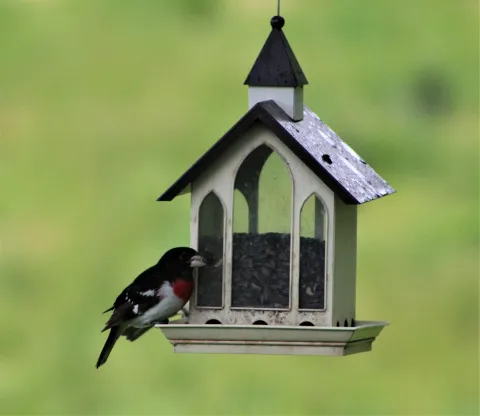Precautionary Bird Feeding

By Steve Roark
Volunteer Interpreter, Cumberland Gap National Historical Park
Bird watching is a favorite pastime for many nature lovers, but it’s often hard to find time to get out and see them. You can enjoy them at home by setting up a feeding station or two. This will also give you the added satisfaction while helping the birds through severe weather, especially extreme cold and snow. Before you begin feeding, keep in mind that once you begin winter feeding, you need to keep it up regularly. The birds become dependent on you, rather than natural sources, and it may prove a great hardship for them if you suddenly stop.
The more food varieties you provide, the greater the variety of birds showing up in your yard. Here are a few common foods used for bird feeding:
Fats: suet can be purchased wherever bird seed is sold, and is readily eaten by many insect eaters, such as woodpeckers and nuthatches. Nutmeats can also be used.
Seeds: sparrows, juncos, cardinals, finches, and many other birds are almost exclusively seed eaters. Commercially mixed bird seed is good, though it often attracts unwanted birds like starlings. Black oil sunflower seed is a good choice, and cracked corn and even some chicken feed mixes can also be used.
Fruit: Robins, mockingbirds, and cedar waxwings are fruit eaters. Dred fruits and berries or freshly cut up apples, oranges, and bananas ca be used.
Miscellaneous: numerous other foods, such as leftover bread, crackers, fatty cakes like doughnuts and pastries, crushed dog biscuits, and some table scraps, will be taken by birds.
There are a wide variety of feeder styles that can be purchased, or they can be homemade. The main thing is to place the feeder where you can see it, and in such a way that the birds are protected from predator, especially cats. Several small feeders are better than one large one.
There is a concern when feeding birds that should be addressed. Drawing birds into close contact on shared surfaces makes it easy for them to spread bacteria like salmonella and E. coli. Reduce disease risk by cleaning your feeder at least once every two weeks by pouring a weak bleach solution through it. (Hummingbird feeders should be cleaned every 3-5 days). Some feeders are designed to come apart for easy cleaning, so consider one of those. Sweep up old, moldy, and discarded seed under your feeders. This will also help reduce disease risk as well as discourage rodents.
- Log in to post comments